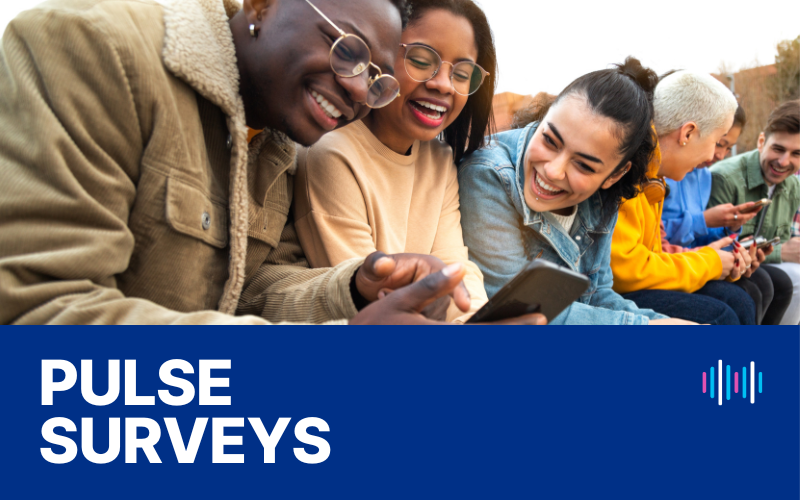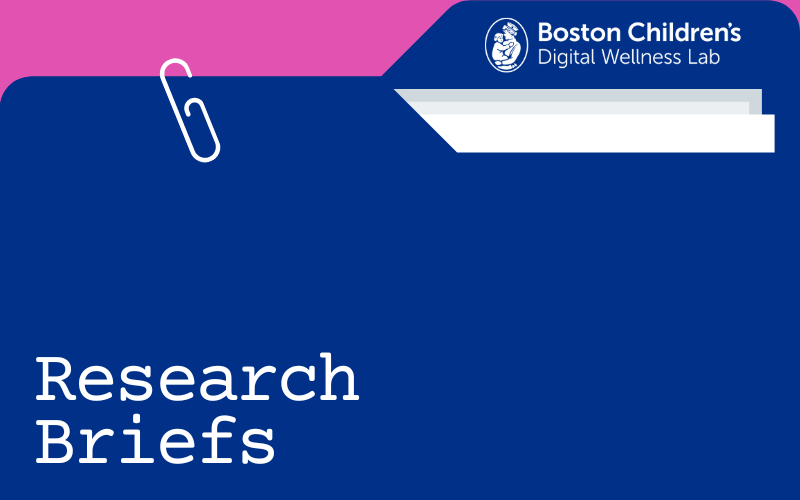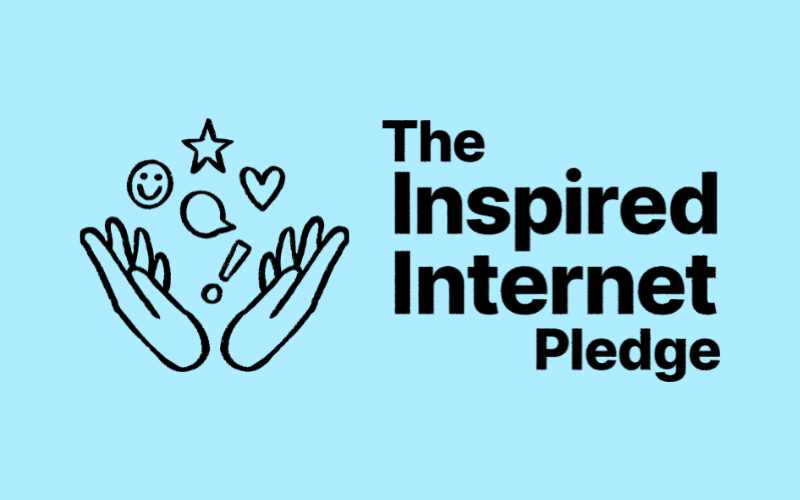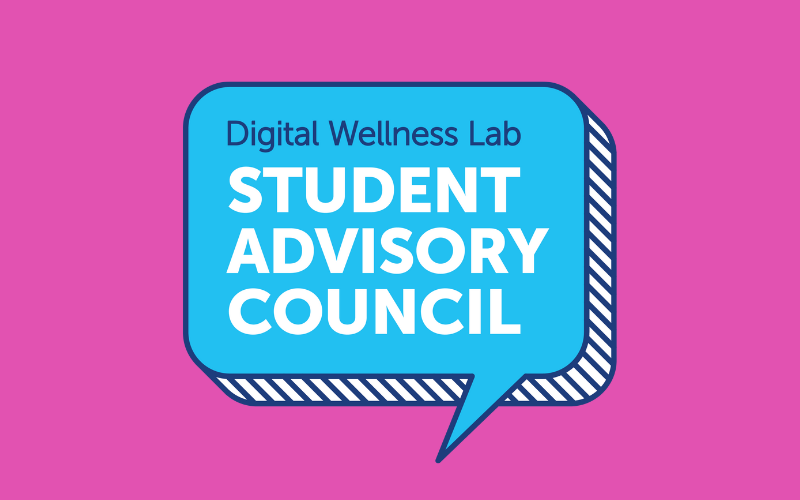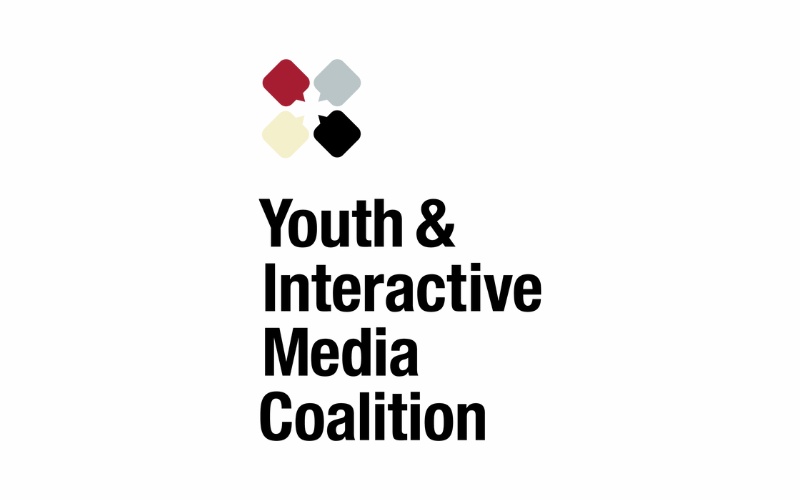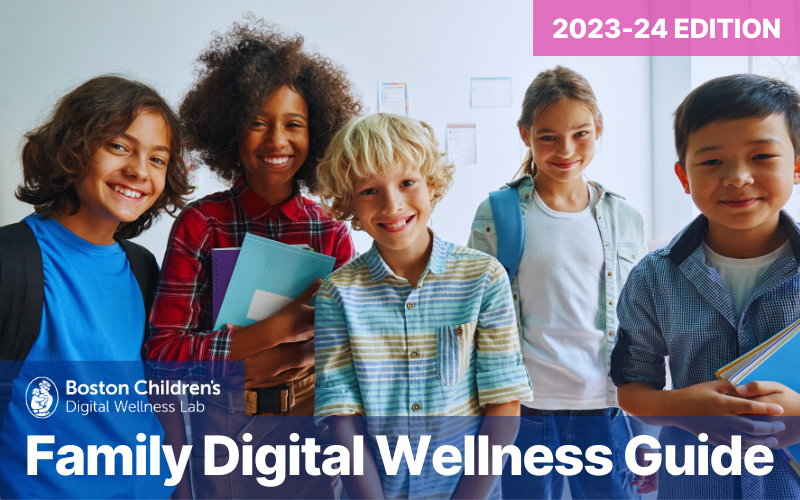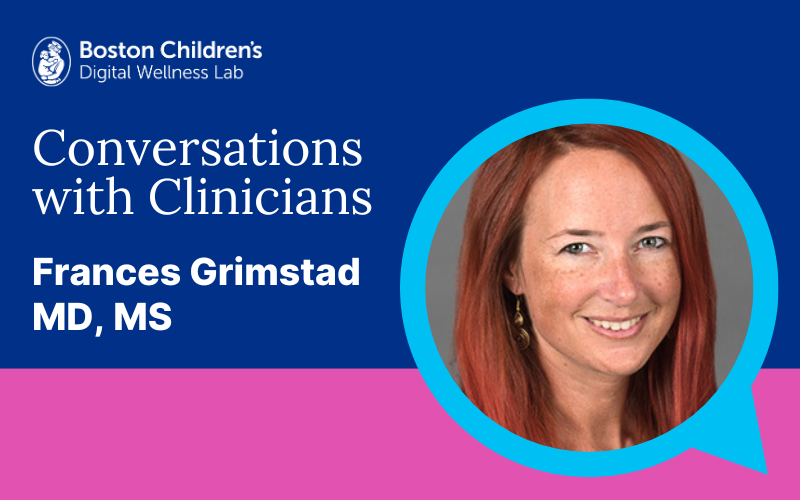Frances Grimstad, MD, MS
Attending, Division of Gynecology, Boston Children’s Hospital
What does “a day in your life” look like?
My days vary greatly and that’s one of the things I love about my job. I have an outpatient clinical practice, a surgical practice, and we see patients inpatient as well. I also do research and clinical advocacy, so on any given day, I might be seeing patients in the clinic, or I might be interspersing that with research meetings with our team, and meeting with students who are interested in going into medicine to do the work we do. I might spend an entire day in the operating room, or I might be in a clinic, or doing research, or participating in meetings for a variety of organizations.
What are the greatest opportunities you see for kids who are growing up in a digitally saturated world?
I first want to say, I’m not a child psychology expert. What I share here are the opinions of a clinician who takes care of children through young adulthood and someone who witnesses the impact of digital saturation in my personal and professional life.
Digital innovations exist as a part of our day-to-day life, and I think it’s important to intentionally figure out how to leverage the good from them. We need to ensure our kids feel comfortable with digital technology. For example, the growth in digital communication is an opportunity to rethink the ways in which we interact with each other. When is texting more appropriate than a phone call, or vice versa. What does it mean to “communicate” by posting a video for the world to see? What is the potential good in that, what is the potential bad? The growth of digital saturation has come at such a clip that those of us who are now adults haven’t had as much of a chance to think about the guardrails, particularly those that are evolving. But the generations growing up in this, they in many ways are going to be leaders in identifying the good – for example meeting new friends in places where before digital technology a person might have otherwise felt isolated, but they will also be key players in helping to identify the bad, and how to set up guardrails around it.
This also leads me to my second opportunity. I think part of confronting this digital saturation is recognizing much of it is in our control. It may not feel that way much of the time, but we made this digital world, and we can mold it! How do we craft a digital world that still upholds the core values of human communication: the ability to listen to one another, to treat one another with respect, and to grow deeply enriched and lasting communities. How do we also recognize that even in a digitally saturated world, many things will never supersede human-to-human interaction?
What are the greatest challenges you see for kids growing up in a digitally saturated world?
I think the bridge between fact and fiction falls apart a bit in a digital era because the ways in which we receive information is far less curated — it doesn’t have some of the same checks and balances that it used to. If we think about libraries and classroom education as no longer being their primary mechanism for information — with today’s information coming from places like Wikipedia (which is built by consensus), but also TikTok and Instagram (where it depends on how a feed is promoted) — the waters get muddy in terms of our younger generation’s ability to discern what is true, what is a priority, what holds values, what holds our ethical codes as a society in comparison to other pieces of information.
For me, teaching our younger generations that just because there is a flood of information on the internet, it does not necessarily mean it is better, or that it is more likely to be right, is a very interesting and challenging issue for our time. We see that in the world of medical information right now. It used to be, and still is to this day, that many teenagers will state that they have made decisions about things like birth control based on what their peers are using. That’s still a little bit of an in-person interaction to a certain extent and probably also a digital interaction, but overall we know there’s a human-to-human connection. I surmise that as time goes on, the number of kids I hear saying they’re getting information online in places like TikTok and Instagram, rather than from their in-person peers, will go up. We’re going to need to augment a lot of the counseling we learned in the 1990’s and early 2000’s in order to respond to medical advice that’s coming from the Internet. It’s not to say that information found online is necessarily worse than the peer-to-peer medical advice — I’m still not sure that if you’re 17 years old and thinking about birth control, that your best friend is necessarily the best judge of medical information! — it’s just a different way of thinking through how we help to educate and counsel our teenagers.
How would you change or design technology or media to be healthier for kids across the developmental span?
One thing I wish we had the ability to control, is the speed at which you can go from one piece of information to another — to scroll — on apps like TikTok, Snapchat, Instagram. I think that there’s a lot of value in sitting and pausing with information, like watching a 5-10 minute video on YouTube or reading a Wikipedia page. It’s what we do with newspapers, books, and conversations.There’s a difference between watching a 10-second video, scrolling through posts at a rapid pace, posting a quick Snap, and moving on, and sitting down and talking with a friend, or even texting with them, about something like birth control. Rapidity feels like a challenge because not only does it provide information flooding, but it really limits our ability to talk about information quality and the ways in which we receive and process information because we can move on from it so quickly. I don’t know what the long term effects are of that kind of speed — it feels very Clockwork Orange — I just think we lose so much in value when we speed things up.
What guidance or advice do you have for parents and other caregivers to help kids build and maintain healthy behaviors around digital media and technology?
First, I would say to help kids use devices in moderation. Second would be to understand that use is going to change across the lifespan, as well as situationally. I think moderation is such an important component, as well as transparency. For example, all of us in the healthcare system today have to be on our phones because our electronic medical record and all of our communication about patients is there. I know that children are going to see us on our phones, it’s very hard for them not to, which doesn’t help them understand and develop appropriate moderation behavior. Therefore, it is important to have very candid conversations — age appropriate as kids are growing up — about why we may be using a phone in a moment we don’t think it’s appropriate for them to use theirs, and why it is that we think it is valuable to turn off devices. Let’s say when we’re out at the beach, when we are going on a hike, that devices can be useful in augmenting and enhancing a lot of our non-technology based experiences, but it’s so valuable that we are still maintaining those non-technology based experiences.
Here at the Lab, we welcome different viewpoints and perspectives. However, the opinions and ideas expressed here do not necessarily represent the views, research, or recommendations of the Digital Wellness Lab, Boston Children’s Hospital, or affiliates.

